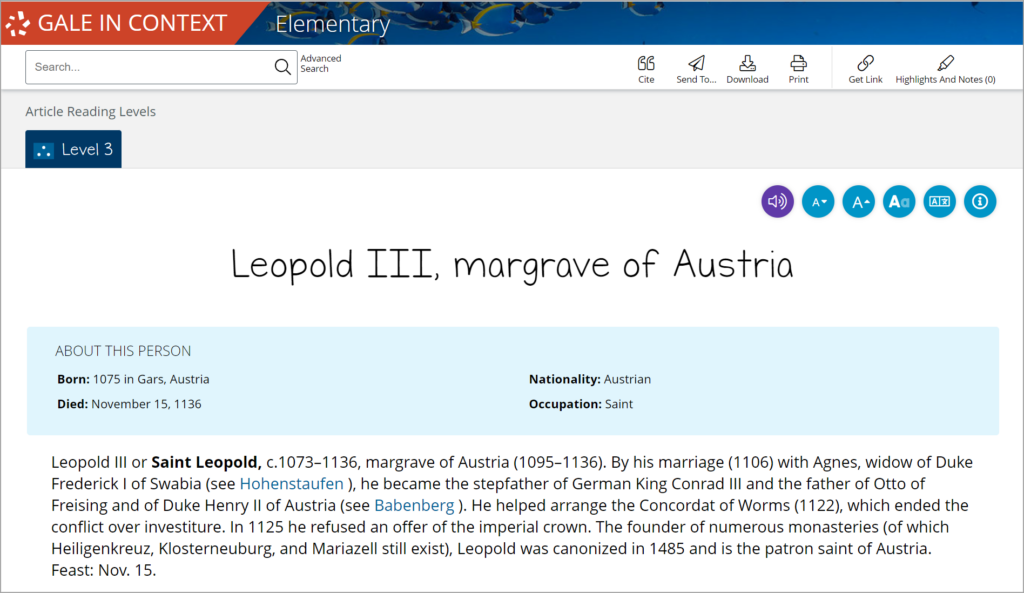| By Gale Staff |
Have you ever wondered how Thanksgiving is celebrated around the world? Teachers can celebrate several holidays in their elementary classrooms throughout the fall semester. Alongside the more traditional and familiar Western observances, educators might embrace a more diversified approach to seasonal holidays, welcoming new perspectives and encouraging young students’ curiosity about other cultures. This fall, in addition to highlighting the Americanized versions, find ways to feature different Thanksgiving-themed celebrations around the world.
Using the valuable, vetted, and age-appropriate content in Gale In Context: Elementary, elementary educators can teach students about authentic American Thanksgiving, but also Yom Kippur, Pongal, and other similar autumnal and winter observances.
For example, many Thanksgiving celebrations around the world involve sharing traditional foods with loved ones, reflecting on the past year, and looking forward to the future. By learning about different Thanksgiving celebrations, students will develop a global perspective and a deeper understanding of different cultures. As you learn about the different holidays worldwide, help your students identify and analyze these cross-cultural similarities.
Take a deep dive into the following unique holiday celebrations and consider ways in which to bring the different customs to your classroom.
Thanksgiving
Thanksgiving is a time for families to come together and celebrate all that they are grateful for. The last Thursday of November is one of the country’s most iconic celebrations, ranking number one on a recent list of the most popular U.S. holidays. While most people are familiar with the story of the first Thanksgiving, when the early colonists shared a bountiful meal with the native Wampanoag tribe, modern Americans recognize Thanksgiving in different ways. From the Macy’s Thanksgiving Day Parade to football games in the backyard to Black Friday shopping, families all have their own unique traditions.
Discussion Idea: To explore the surprising similarities between different cultural holidays, invite students to share their favorite Thanksgiving customs. Then, research other seasonal holidays around the world to see if you can find similar traditions.

Yom Kippur
Yom Kippur is one of the most important holidays in the Jewish calendar. It is a day of atonement and renewal, a time for Jewish people to reflect on their past mistakes and commit to making better choices in the future.
This year, Yom Kippur lasts from sunset on September 24, 2023, through nightfall on September 25, 2023. At the end of the day, Jewish people gather for a special meal called the Seder. This meal is a time for celebration and renewal. People reflect on the lessons they have learned from Yom Kippur and commit to living better lives in the year ahead.
Activity Idea: Read a story about Yom Kippur traditions or one with themes about forgiveness and learning from past mistakes. Then, have your students write about a time that they made a mistake and what they can learn from it.
Pongal
Did you know there’s a harvest festival in India that’s just as important as Thanksgiving? Pongal is a multi-day harvest festival celebrated in certain regions in India and by those with Indian heritage living throughout the world. During this holiday, which typically falls in the middle of January, people express gratitude to nature and farm animals for their contributions to a bountiful harvest—much like American Thanksgiving. As your young learners further research Pongal’s exciting customs, encourage them to identify additional links between the two holidays.
Activity Idea: Sugarcane, representing happiness, is an important symbol during Pongal celebrations. Explore more of the unique ingredients used in Pongal recipes, and maybe even try making and sampling a special treat as a class.
Other Worldwide Harvest Festivals
Many countries celebrate their own Thanksgiving or a holiday with similar themes. Canada’s Thanksgiving falls in October, rather than November, due to the country’s colder climate and earlier harvest. In fact, the first Canadian Thanksgiving feast in 1578 predates the American version (in 1621).
In Japan, cities host massive harvest festivals in October, many with colorful parades and special delicacies. In Austria, citizens recognize St. Leopold’s Day in memory of Leopold III, Margrave of Austria, and the country’s patron saint. Traditionally, Austrian families gather for a special meal of roast goose.
There are dozens of celebrations throughout the fall season, each with its unique cultural twists and history that your students can discover.
Activity Idea: Assign each student to a different country. Using Gale In Context: Elementary, have them research that country’s fall and winter holidays and create a brief report. Then, have students share what they’ve learned with the class, paying special attention to the similarities between the different countries and religions.

Integrate Extra Support
Elementary teachers have many responsibilities to juggle. From general classroom safety to literacy rates, each day brings a new challenge to overcome. This school year, Gale is excited to offer teachers a dedicated educator platform titled Gale In Context: For Educators. Your institution can easily invest in this resource alongside Gale In Context: Elementary and the two databases work together seamlessly.
Gale In Context: For Educators supports your daily curricular goals with supplemental instructional materials, ready-made lesson plans, and engaging classroom activities. Plus, all of the content aligns with national and state standards, and materials are created and vetted by an expert team. In addition to the convenient content, you can use tools from the platform to increase collaboration and productivity. Teachers can create personalized assignments and leverage integration features with your district’s preferred learning management system. You can even customize articles with your own notes and thought-provoking questions to help guide students through the material.
Teaching young students about holidays from other countries and cultures helps them appreciate differences and identify shared values, like family, good food, warmth, and gratitude. These lessons develop empathy and curiosity and the foundations for success and compassion.
If you’re interested in learning more about Gale resources like Gale In Context: Elementary and Gale In Context: For Educators, contact your local representative to ask about a trial period.

